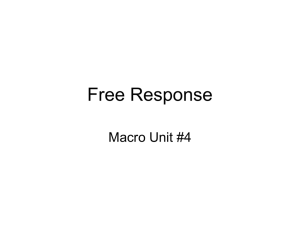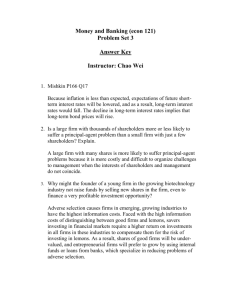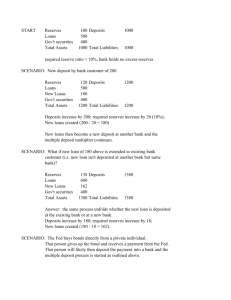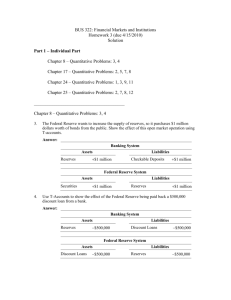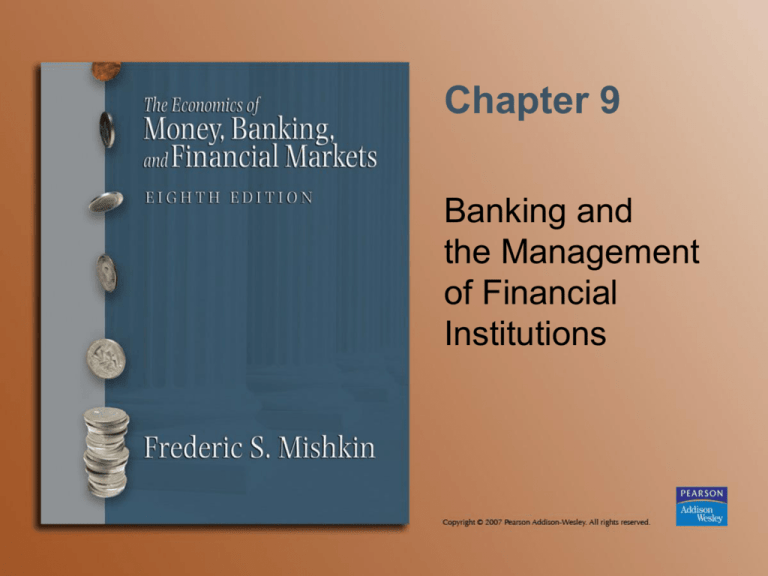
Chapter 9
Banking and
the Management
of Financial
Institutions
Copyright © 2007 Pearson Addison-Wesley. All rights reserved.
9-2
Basic Banking—Cash Deposit
First National Bank
Assets
Vault
Cash
+$100
First National Bank
Liabilities
Checkable
deposits
+$100
Assets
Reserves
Liabilities
+$100 Checkable
deposits
+$100
• Opening of a checking account leads to an
increase in the bank’s reserves equal to the
increase in checkable deposits
Copyright © 2007 Pearson Addison-Wesley. All rights reserved.
9-3
Basic Banking—Check Deposit
When a bank receives
First National Bank
Assets
Cash items
in process
of collection
Liabilities
+$100
Checkable
deposits
+$100
when it loses deposits,
it loses an equal amount of reserves
First National Bank
Assets
additional deposits, it
gains an equal amount of reserves;
Second National Bank
Liabilities
Reserves +$100 Checkable
deposits
+$100
Copyright © 2007 Pearson Addison-Wesley. All rights reserved.
Assets
Reserves
-$100
Liabilities
Checkable
deposits
-$100
9-4
Basic Banking—Making a Profit
First National Bank
Assets
Required
reserves
Excess
reserves
Second National Bank
Liabilities
+$100 Checkable
deposits
+$100
+$90
Assets
Required
reserves
Loans
Liabilities
+$100 Checkable
deposits
+$100
+$90
• Asset transformation-selling liabilities with one set of
characteristics and using the proceeds to buy assets
with a different set of characteristics
• The bank borrows short and lends long
Copyright © 2007 Pearson Addison-Wesley. All rights reserved.
9-5
Bank Management
• Liquidity Management
• Asset Management
• Liability Management
• Capital Adequacy Management
• Credit Risk
• Interest-rate Risk
Copyright © 2007 Pearson Addison-Wesley. All rights reserved.
9-6
Liquidity Management:
Ample Excess Reserves
Assets
Liabilities
Reserves
$20M Deposits
Loans
$80M Bank
Capital
$10M
Securities
$100M
$10M
Assets
Liabilities
Reserves
$10M Deposits
$90M
Loans
$80M Bank
Capital
$10M
$10M
Securities
• If a bank has ample excess reserves, a
deposit outflow does not necessitate changes
in other parts of its balance sheet
Copyright © 2007 Pearson Addison-Wesley. All rights reserved.
9-7
Liquidity Management:
Shortfall in Reserves
Assets
Liabilities
Reserves
$10M Deposits
Loans
$90M Bank
Capital
$10M
Securities
$100M
$10M
Assets
Reserves
Loans
Securities
Liabilities
$0 Deposits
$90M Bank
Capital
$10M
$90M
$10M
• Reserves are a legal requirement and the
shortfall must be eliminated
• Excess reserves are insurance against the
costs associated with deposit outflows
Copyright © 2007 Pearson Addison-Wesley. All rights reserved.
9-8
Liquidity Management: Borrowing
Assets
Reserves
Liabilities
$9M Deposits
$90M
Loans
$90M Borrowing
$9M
Securities
$10M Bank Capital
$10M
• Cost incurred is the interest rate paid on the
borrowed funds
Copyright © 2007 Pearson Addison-Wesley. All rights reserved.
9-9
Liquidity Management:
Securities Sale
Assets
Reserves
Loans
Securities
Liabilities
$9M Deposits
$90M Bank Capital
$90M
$10M
$1M
• The cost of selling securities is the brokerage
and other transaction costs
Copyright © 2007 Pearson Addison-Wesley. All rights reserved.
9-10
Liquidity Management:
Federal Reserve
Assets
Reserves
Liabilities
$9M Deposits
Loans
$90M Borrow from Fed
Securities
$10M Bank Capital
$90M
$9M
$10M
• Borrowing from the Fed also incurs interest
payments based on the discount rate
Copyright © 2007 Pearson Addison-Wesley. All rights reserved.
9-11
Liquidity Management: Reduce Loans
Assets
Reserves
Liabilities
$9M Deposits
Loans
$81M Bank Capital
Securities
$10M
$90M
$10M
• Reduction of loans is the most costly way of
acquiring reserves
• Calling in loans antagonizes customers
• Other banks may only agree to purchase loans at a
substantial discount
Copyright © 2007 Pearson Addison-Wesley. All rights reserved.
9-12
Asset Management: Three Goals
• Seek the highest possible returns on
loans and securities
• Reduce risk
• Have adequate liquidity
Copyright © 2007 Pearson Addison-Wesley. All rights reserved.
9-13
Asset Management: Four Tools
• Find borrowers who will pay high
interest rates and have low possibility
of defaulting
• Purchase securities with high returns
and low risk
• Lower risk by diversifying
• Balance need for liquidity against
increased returns from less liquid assets
Copyright © 2007 Pearson Addison-Wesley. All rights reserved.
9-14
Liability Management
• Recent phenomenon due to rise of
money center banks
• Expansion of overnight loan markets and
new financial instruments (such as
negotiable CDs)
• Checkable deposits have decreased in
importance as source of bank funds
Copyright © 2007 Pearson Addison-Wesley. All rights reserved.
9-15
Capital Adequacy Management
• Bank capital helps prevent bank failure
• The amount of capital affects return for
the owners (equity holders) of the bank
• Regulatory requirement
Copyright © 2007 Pearson Addison-Wesley. All rights reserved.
9-16
Capital Adequacy Management:
Preventing Bank Failure When
Assets Decline
High Bank Capital
Assets
Liabilities
Low Bank Capital
Assets
Liabilities
Reserves
$10M Deposits
$90M Reserves
$10M Deposits
Loans
$90M Bank Capital
$10M Loans
$90M Bank Capital
High Bank Capital
Assets
Liabilities
Reserves
$10M Deposits
Loans
$85M Bank Capital
Copyright © 2007 Pearson Addison-Wesley. All rights reserved.
$96M
$4M
Low Bank Capital
Assets
$90M Reserves
$5M Loans
Liabilities
$10M Deposits
$96M
$85M Bank Capital
-$1M
9-17
Capital Adequacy Management:
Returns to Equity Holders
Return on Assets: net profit after taxes per dollar of assets
net profit after taxes
assets
Return on Equity: net profit after taxes per dollar of equity capital
ROA =
ROE =
net profit after taxes
equity capital
Relationship between ROA and ROE is expressed by the
Equity Multiplier: the amount of assets per dollar of equity capital
EM =
Assets
Equity Capital
net profit after taxes net profit after taxes
assets
equity capital
assets
equity capital
ROE = ROA EM
Copyright © 2007 Pearson Addison-Wesley. All rights reserved.
9-18
Capital Adequacy
Management: Safety
• Benefits the owners of a bank by making
their investment safe
• Costly to owners of a bank because the
higher the bank capital, the lower the
return on equity
• Choice depends on the state of the
economy and levels of confidence
Copyright © 2007 Pearson Addison-Wesley. All rights reserved.
9-19
Credit Risk: Overcoming Adverse
Selection and Moral Hazard
• Screening and information collection
• Specialization in lending
• Monitoring and enforcement of
restrictive covenants
• Long-term customer relationships
• Loan commitments
• Collateral and compensating balances
• Credit rationing
Copyright © 2007 Pearson Addison-Wesley. All rights reserved.
9-20
Interest-Rate Risk
First National Bank
Assets
Rate-sensitive assets
Liabilities
$20M Rate-sensitive liabilities
$50M
Variable-rate and short-term loans
Variable-rate CDs
Short-term securities
Money market deposit accounts
Fixed-rate assets
$80M Fixed-rate liabilities
Reserves
Checkable deposits
Long-term loans
Savings deposits
Long-term securities
Long-term CDs
$50M
Equity capital
• If a bank has more rate-sensitive liabilities than assets, a rise in
interest rates will reduce bank profits and a decline in interest
rates will raise bank profits
Copyright © 2007 Pearson Addison-Wesley. All rights reserved.
9-21
Interest Rate Risk: Gap Analysis
Basic Gap Analysis:
(rate-sensitive assets rate sensitive liabilities)
interest rates = in bank profits
Maturity Bucket Approach
measures the gap for several maturity subintervals
Standardized Gap Analysis
accounts for differing degrees of rate sensitivity
Copyright © 2007 Pearson Addison-Wesley. All rights reserved.
9-22
Interest Rate Risk: Duration Analysis
Duration Analysis:
% market value of security
percentage point interest rate duration in years
Uses the weighted average duration of
a financial institution's assets and of its liabilities
to see how net worth responds to a change in
interest rates
Copyright © 2007 Pearson Addison-Wesley. All rights reserved.
9-23
Off-Balance-Sheet Activities
• Loan sales (secondary loan
participation)
• Generation of fee income
• Trading activities and risk management
techniques
Futures, options, interest-rate swaps,
foreign exchange
Speculation
Copyright © 2007 Pearson Addison-Wesley. All rights reserved.
9-24
Off-Balance-Sheet Activities (cont’d)
• Trading activities and risk management
techniques (cont’d)
Principal-agent problem
Internal Controls
• Separation of trading activities and bookkeeping
• Limits on exposure
• Value-at-risk
• Stress testing
Copyright © 2007 Pearson Addison-Wesley. All rights reserved.
9-25


